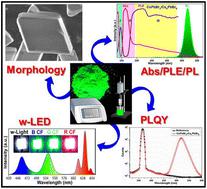Our official English website, www.x-mol.net, welcomes your
feedback! (Note: you will need to create a separate account there.)
Highly luminescent dual-phase CsPbBr3/Cs4PbBr6 microcrystals for a wide color gamut for backlight displays
Nanoscale ( IF 5.8 ) Pub Date : 2022-11-16 , DOI: 10.1039/d2nr05653d V Naresh 1 , Taehyung Jang 2 , Yoonsoo Pang 2 , Nohyun Lee 1
Nanoscale ( IF 5.8 ) Pub Date : 2022-11-16 , DOI: 10.1039/d2nr05653d V Naresh 1 , Taehyung Jang 2 , Yoonsoo Pang 2 , Nohyun Lee 1
Affiliation

|
Cesium lead bromide perovskite nanocrystals (NCs) embedded in Cs4PbBr6 or CsPb2Br5 matrices forming core/shell structures are promising luminescent materials that exhibit remarkable photoluminescence properties meeting the need in a wide range of applications while overcoming stability challenges. Here, we report the large-scale, ligand-free synthesis of dual-phase Cs4PbBr6/CsPbBr3 microcrystals (MCs) using ultrasonication at room temperature, exhibiting a high photoluminescence quantum yield (PLQY) of 82.7% and good stability. High-resolution transmission electron microscopy and X-ray photoelectron characterization confirm that CsPbBr3 NCs are embedded in the Cs4PbBr6 matrix-forming CsPbBr3/Cs4PbBr6 dual-phase structure. The evolution of the luminescence properties with temperature suggests that the strong green emission results from direct exciton recombination in the isolated [PbBr6]4− octahedra, which possess a large exciton binding energy of 283.6 meV. As revealed from their emission intensities, the dual-phase CsPbBr3/Cs4PbBr6 MCs demonstrate excellent stability against ultraviolet irradiation (76%), good moisture resistance (42.7%), and good thermal tolerance (51%). It is understood that such excellent PLQY and stability are due to the surface passivation of the CsPbBr3 NCs attributed to the large bandgap as well as the isolated [PbBr6]4− octahedra separated by Cs+ ions in the Cs4PbBr6 crystal lattice. Finally, the suitability of the green-emitting CsPbBr3/Cs4PbBr6 material for achieving white-light emission and a wide color gamut is evaluated by constructing a prototype white light-emitting diode (w-LED) using CsPbBr3/Cs4PbBr6 and red-emitting K2SiF6:Mn4+ materials taken in different weight ratios and combined with a blue light-emitting InGaN LED chip (λ = 455 nm). The constructed w-LED device exhibits the color coordinates (0.3315, 0.3289), an efficacy of 68 lm W−1, a color rendering index of 87%, a color temperature of 5564 K, and a wide color gamut of ∼118.78% (NTSC) and ∼88.69% (Rec. 2020) with RGB color filters in the CIE 1931 color space. Therefore, based on our present findings, we strongly believe that the dual-phase CsPbBr3/Cs4PbBr6 material is a promising green-emitting phosphor for use in w-LEDs as the backlight of display systems.
中文翻译:

用于背光显示器的宽色域的高发光双相 CsPbBr3/Cs4PbBr6 微晶
嵌入 Cs 4 PbBr 6或 CsPb 2 Br 5基质中形成核/壳结构的铯溴化铅钙钛矿纳米晶体 (NCs) 是很有前途的发光材料,具有显着的光致发光特性,可满足广泛应用的需求,同时克服稳定性挑战。在这里,我们报告了在室温下使用超声处理大规模、无配体合成双相 Cs 4 PbBr 6 /CsPbBr 3微晶 (MC),表现出 82.7% 的高光致发光量子产率 (PLQY) 和良好的稳定性。高分辨率透射电子显微镜和 X 射线光电子表征证实 CsPbBr 3NC嵌入Cs 4 PbBr 6基质中形成CsPbBr 3 /Cs 4 PbBr 6双相结构。发光特性随温度的演变表明,强烈的绿色发射是由孤立的 [PbBr 6 ] 4−八面体中的直接激子复合引起的,其具有 283.6 meV 的大激子结合能。从它们的发射强度可以看出,双相 CsPbBr 3 /Cs 4 PbBr 6MCs 表现出优异的抗紫外线稳定性 (76%)、良好的防潮性 (42.7%) 和良好的耐热性 (51%)。据了解,如此出色的 PLQY 和稳定性是由于 CsPbBr 3 NC 的表面钝化归因于大带隙以及Cs 4 PbBr 6晶格中被 Cs +离子分隔的孤立的 [PbBr 6 ] 4−八面体. 最后,通过使用 CsPbBr 构建原型白光发光二极管 (w-LED),评估了绿光 CsPbBr 3 /Cs 4 PbBr 6材料实现白光发射和宽色域的适用性3 /Cs 4 PbBr 6和发红光的K 2 SiF 6 :Mn 4+材料以不同的重量比与发蓝光的InGaN LED芯片( λ = 455 nm)组合。构建的 w-LED 器件的色坐标为 (0.3315, 0.3289),光效为 68 lm W -1,显色指数为 87%,色温为 5564 K,宽色域为 ∼118.78% ( NTSC) 和 ~88.69% (Rec. 2020),在 CIE 1931 色彩空间中使用 RGB 滤色器。因此,根据我们目前的发现,我们坚信双相 CsPbBr 3 /Cs 4 PbBr 6材料是一种很有前途的绿色荧光粉,可用于 w-LED 作为显示系统的背光源。
更新日期:2022-11-16
中文翻译:

用于背光显示器的宽色域的高发光双相 CsPbBr3/Cs4PbBr6 微晶
嵌入 Cs 4 PbBr 6或 CsPb 2 Br 5基质中形成核/壳结构的铯溴化铅钙钛矿纳米晶体 (NCs) 是很有前途的发光材料,具有显着的光致发光特性,可满足广泛应用的需求,同时克服稳定性挑战。在这里,我们报告了在室温下使用超声处理大规模、无配体合成双相 Cs 4 PbBr 6 /CsPbBr 3微晶 (MC),表现出 82.7% 的高光致发光量子产率 (PLQY) 和良好的稳定性。高分辨率透射电子显微镜和 X 射线光电子表征证实 CsPbBr 3NC嵌入Cs 4 PbBr 6基质中形成CsPbBr 3 /Cs 4 PbBr 6双相结构。发光特性随温度的演变表明,强烈的绿色发射是由孤立的 [PbBr 6 ] 4−八面体中的直接激子复合引起的,其具有 283.6 meV 的大激子结合能。从它们的发射强度可以看出,双相 CsPbBr 3 /Cs 4 PbBr 6MCs 表现出优异的抗紫外线稳定性 (76%)、良好的防潮性 (42.7%) 和良好的耐热性 (51%)。据了解,如此出色的 PLQY 和稳定性是由于 CsPbBr 3 NC 的表面钝化归因于大带隙以及Cs 4 PbBr 6晶格中被 Cs +离子分隔的孤立的 [PbBr 6 ] 4−八面体. 最后,通过使用 CsPbBr 构建原型白光发光二极管 (w-LED),评估了绿光 CsPbBr 3 /Cs 4 PbBr 6材料实现白光发射和宽色域的适用性3 /Cs 4 PbBr 6和发红光的K 2 SiF 6 :Mn 4+材料以不同的重量比与发蓝光的InGaN LED芯片( λ = 455 nm)组合。构建的 w-LED 器件的色坐标为 (0.3315, 0.3289),光效为 68 lm W -1,显色指数为 87%,色温为 5564 K,宽色域为 ∼118.78% ( NTSC) 和 ~88.69% (Rec. 2020),在 CIE 1931 色彩空间中使用 RGB 滤色器。因此,根据我们目前的发现,我们坚信双相 CsPbBr 3 /Cs 4 PbBr 6材料是一种很有前途的绿色荧光粉,可用于 w-LED 作为显示系统的背光源。











































 京公网安备 11010802027423号
京公网安备 11010802027423号